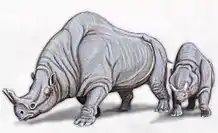Pakotitanops
Pakotitanops latidentatus is a poorly known brontothere represented only by a few tooth fragments.[1] Its fossil dates from the middle Eocene Kuldana Formation, in the Ganda Kas area of Pakistan. Because this species is known only from a few tooth fragments it is difficult to compare it to other species to determine if it is indeed a distinct species and to what other species it is mostly closely related.
| Pakotitanops Temporal range: Middle Eocene | |
|---|---|
| Scientific classification | |
| Kingdom: | Animalia |
| Phylum: | Chordata |
| Class: | Mammalia |
| Order: | Perissodactyla |
| Family: | †Brontotheriidae |
| Genus: | †Pakotitanops West, 1980 |
| Species: | †P. latidentatus |
| Binomial name | |
| †Pakotitanops latidentatus West, 1980 | |
Other brontotheres from Pakistan include Eotitanops? dayi and Mulkrajanops moghliensis. Pakotitanops is larger than either of these species. The dental fragments are most similar in size and shape to Dolichorhinus, a North American brontothere from the middle Eocene, and possibly represents a close Asian relative of Pakotitanops.
References
- West, Robert M. (1980). "Middle Eocene large mammal assemblage with Tethyan affinities, Ganda Kas region, Pakistan". Journal of Paleontology. 54: 508–533.
- Mihlbachler, Matthew Christian (2005). "Phylogenetic Systematics of the Brontotheriidae (Mammalia, Perissodactyla)". Ph.D. dissertation. Columbia University. Archived from the original on 2007-06-10. Cite journal requires
|journal=(help) - Thewissen, Johannes G.M.; Williams, Ellen M.; Hussain, S. Taseer (2001). "Eocene mammal faunas from Northern Indo-Pakistan". Journal of Vertebrate Paleontology. 21 (2): 347–366. doi:10.1671/0272-4634(2001)021[0347:EMFFNI]2.0.CO;2.
This article is issued from Wikipedia. The text is licensed under Creative Commons - Attribution - Sharealike. Additional terms may apply for the media files.
